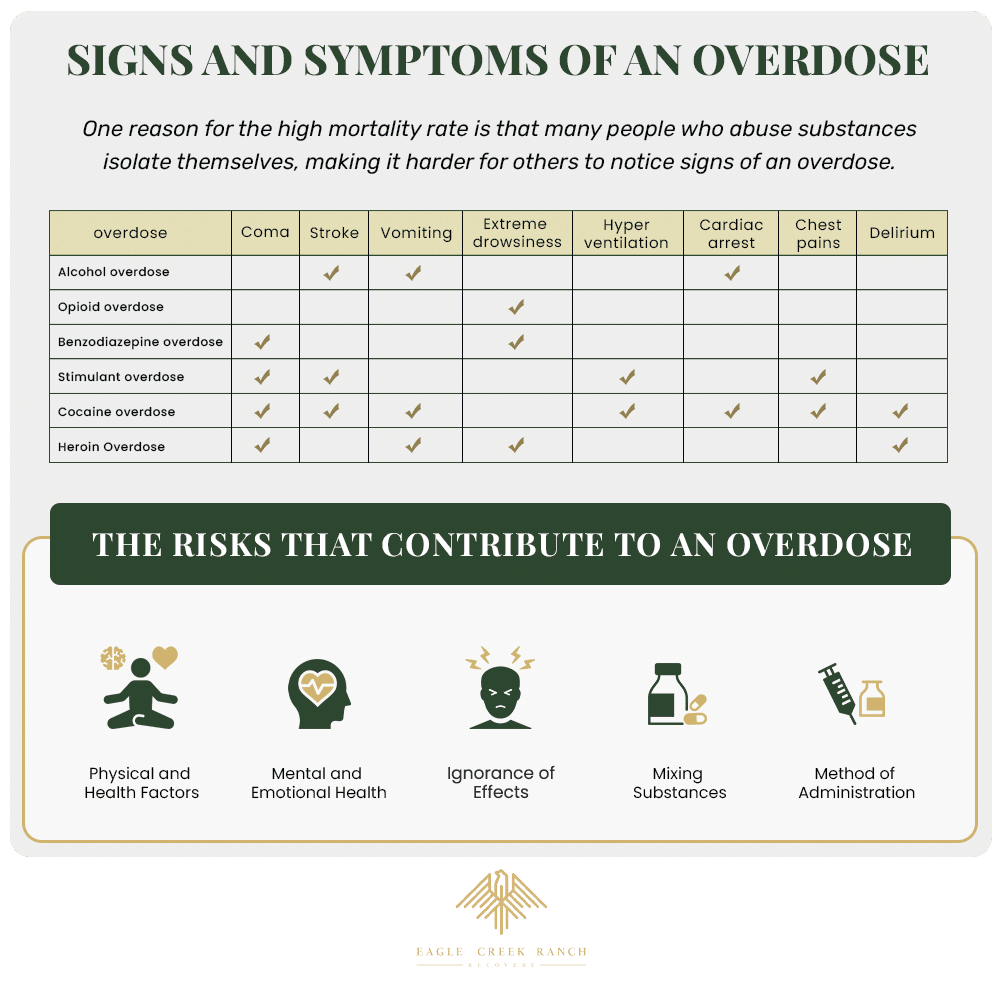Signs of An Overdose: Recognizing What to Do Next
Illicit substance use has steadily grown over the years, and most recently it has already reached epidemic proportions, with the Centers for Disease Control and Prevention (CDC) revealing that at least 110,236 Americans have died in 2022 due to drug overdose-related causes. One of the reasons for the high mortality rate is that many people who are into substance abuse choose isolation and are mostly hidden away from anyone who could notice that they are already exhibiting signs of an overdose.
This most recent figure is already at a record high, and the alarming fact is that there is no indication that the number is going down anytime soon. Some studies suggest that the recent pandemic has done nothing to slow it down, and has instead made it worse due to the isolation that came with the quarantine. The pandemic has also significantly made treatment at detox centers harder to access, which also accounts for the sharp spike in overdose-related deaths.
At Eagle Creek Ranch Recovery in Nampa, Idaho, we offer recovery resources to help people recognize the signs of an overdose and do our job to help lessen the rate at which they are occurring.

As different people often misuse different drugs, there are marked differences in the signs and symptoms of a drug-related overdose incident.
- Significant mental confusion
- Stupor
- Difficulty remaining conscious
- Completely unconscious
- Lack of responsiveness
- Cannot be roused or woken up
- Seizures
- Vomiting
- Bradypnea (significantly slowed breathing)
- Bradycardia (radically slowed heart rate)
- Very low body temperature
- Pale or blue-tinged skin
- Clammy skin
- Significantly dulled senses
- Impaired physical responses (including loss of gag reflex)
- Slurred or incoherent speech
- Loss of coordination
- Loss of bowel control
- Loss of bladder control
- Cardiac arrest
- Loss of consciousness
- Significantly constricted or pinpoint pupils
- Marked difficulty in breathing
- Respiratory arrest (completely stopped breathing)
- Choking, gurgling, or snoring sounds
- Discoloration of lips or fingertips (blue or grey tinge)
- Being completely unresponsive
- Limp body
- Severe dizziness
- Extreme drowsiness
- Inability to sit up
- Inability to walk
- Severely cognitive functions
- Significant confusion
- Slurred speech
- Slowed, shallow, or labored breathing
- Respiratory arrest
- Coma
- Extreme drowsiness
- Loss of coordination
- Somnolence (extreme sleepiness or prolonged periods of sleep)
- Diplopia (double vision)
- Anterograde amnesia (inability to create new memories)
- Ataxia (Lack of coordination, trouble eating and swallowing, deterioration of fine motor skills, difficulty walking, gait abnormalities, eye movement abnormalities, tremors)
- Dangerously high body temperature
- Hyperventilation (rapid breathing)
- Tachycardia (rapid heart rate)
- Hypertension (elevated blood pressure)
- Stroke
- Heart attack
- Circulatory compromise
- Panic
- Hallucinations
- Paranoia
- Psychosis
- Unwarranted aggression
- Seizures and convulsions
- Kidney failure
- Severe stomach pain
- Extreme agitation
- Chest pains
- Unresponsive to stimuli
- Coma
- Tachycardia (elevated heart rate)
- Elevated body temperature
- Nausea
- Vomiting
- Chest pains
- Tremors
- Panic
- Anxiety
- Delirium
- Paranoia
- Hyperventilation
- Convulsions
- Stroke
- Lung failure
- Cardiac arrest
- Coma
- Severe pulmonary depression (gasping for air or shallow breathing)
- Discoloration of fingertips and lips (blue tinge)
- Extreme drowsiness
- Inability to stay awake
- Nausea
- Vomiting
- Spasms and twitches
- Seizures
- Constipation
- Severe disorientation
- Delirium
- Altered mental state
- Hypotension (severely low blood pressure)
- Weak pulse
- Discolored tongue
- Pinpoint pupils
- Coma

Contact Eagle Creek Ranch Recovery
Recovery Today!
Why Wait? Find The Help You Need By Reaching Out To Us Today! Our Admissions Team Is Standing By.
What are the Risks that Contribute to an Overdose?
Depending on the person, certain risk factors make an overdose more likely, including:
A person’s tolerance could work in one of two ways. A person with a low drug or medication tolerance could potentially suffer from an unintended overdose if the particular medication happens to be quite potent. For those with a particular sensitivity to substances, even the slightest bit over the tolerable quantity could already constitute an overdose and trigger the symptoms.
Conversely, a person with a high tolerance could experience a delay in the effect of the taken drug or medication, in which case, the person might try to take more of it, or before the prescribed frequency. In this manner, the delay in effect plus the added quantity could trigger an overdose. A person’s tolerance level could also change with specific changes in behavior towards medication, such as when a person spends time in addiction treatment, in rehab, or when the medication or substance has not been taken for a long while.
The fastest way for any kind of drug or medication to get into the system is usually through intravenous routes, as this introduces the substance directly into the bloodstream. As such, it is immediately circulated where the blood goes. Depending upon the person’s reaction to the medication or substance, some people tend to need a bit more time when it comes to absorbing and processing the medication, while others need quick-acting medications.
Medication or drugs taken orally will necessarily have to go through the digestive system first before it is delivered into the bloodstream. The time spent in the digestive system could already be a time for the person to “acclimate” to the substance, which is not the case when the medication is delivered intravenously.
People with certain mental health issues are particularly at risk of an overdose due to several reasons. One reason is that many people who suffer from depression would want to take more of any substance that reduces the melancholy or misery that they feel. People who suffer from panic attacks may want to take more or any medication that calms them, and so on.
Some people with mental health issues that cause significant stress, such as post-traumatic stress disorder (PTSD) may take anything to reduce the distress that their condition brings, including highly toxic substances. These individuals with dual diagnoses will need PTSD and addiction treatment to help them recover from their suffering.
Reading the label and contraindication could spell the difference between being relieved and going on an overdose when it comes to medication. Many people end up in the emergency room not knowing that there was something in the medication they took that they should not be exposed to, or should not have taken under certain circumstances.
In cases where a person takes a substance illicitly, the danger lies in the actual purity of the substance being taken. It is not uncommon for many drug dealers to “cut” or mix an additive to substances they sell just to increase their supply. This is common with fentanyl addiction cases, and why so many people overdose or die, as they are unaware of what’s in the drugs that were sold to them.
Another highly dangerous practice of many people who take substances is mixing different substances just to intensify the effect. The accumulated chemicals could become highly toxic and cause severe damage to the body, even if taken in relatively small quantities. In cases where people mix alcohol and drugs, the effect is quite similar, as the combination could quickly impair the person’s reasoning abilities, causing them to lose track of how much they had already consumed, thus leading to an overdose.
In most cases, many people fail to realize that alcohol could act as a catalyst for certain substances, depending on their chemical composition. When this happens, the substance is taken changes in chemical composition and could become something highly toxic, even in small quantities. These people will have to go to an alcoholism rehab to recover.
Just like a person’s natural tolerance for certain substances, a person with a preexisting condition could be particularly sensitive to certain substances, which could cause significant effects when taken by the person with the condition. In certain instances, people with maintenance medications could suffer from an overdose because of the reaction of another substance with the chemical compounds still in their bodies because of the maintenance medication they take regularly.
In many cases, the cause of the overdose is not even anywhere near illicit use. One example is in people who take medication intended to regulate their blood pressure. Certain substances, such as energy drinks, might appear completely harmless but could be damaging when taken by people who have conditions that don’t mix well with them. Energy drinks are known to be infused with a large amount of sugar and even stimulants, such as caffeine. Depending on the quantity consumed, this could cause a person’s blood pressure to spike to levels it should not go to.
The recent pandemic and the ensuing quarantine served to increase the number of people succumbing to the lethal effects of an overdose. Most would think that those who suffered an overdose would be only those who took substances illicitly, but in reality, there were also reports of people who suffered an overdose because they were forced to use medication while in isolation. Some of these people were forced to use other medications in place of what they typically took because they could not procure more of their usual due to the quarantine.
Others had the misfortune of not knowing what they were taking, and with no one around to help them due to the quarantine, they also suffered from either an overdose or the toxicity of medication they should not have taken. This was particularly true with elderly people who did not have their usual caregivers to assist them with their usual medication.

It’s Not Too Late to Get Help with Eagle Creek Ranch Recovery
An overdose is always a possibility when substances or medications are not properly handled. This possibility is even greater for someone who suffers from a substance abuse disorder. This is why we here at Eagle Creek Ranch Recovery, our drug rehab strive to help people in understanding what they’re going through, and how to effectively manage it. Contact us today and let us help you recover.

Clinical Director
Kendall Maloof is the clinical director at Eagle Creek Ranch Recovery. She is a licensed marriage and family therapist and has held multiple leadership roles before settling here at Eagle Creek Ranch Recovery. Kendall received her master’s degree in marriage and family therapy from the Chicago School of Professional Psychology in 2016. Her career in mental and behavioral health began in 2014 when she took up internships in both the nonprofit and for profit sectors. She interned at multiple reputable companies, such as The Living Success Center and 449 Recovery in California.
In 2019, Kendall became the clinical director of Sunsets Recovery for Woman, a dual diagnosis program in southern California. Kendall is a natural leader. She has an incredible ability to problem solve and stay calm in any situation. Kendall never fails to show up when she is needed, and her calm demeanor makes her team and clients feel at ease. Eagle Creek Ranch Recovery is proud to have Kendall as our clinical director.


